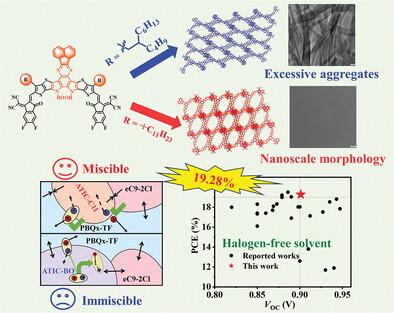当前位置:
X-MOL 学术
›
Adv. Mater.
›
论文详情
Our official English website, www.x-mol.net, welcomes your
feedback! (Note: you will need to create a separate account there.)
Balanced Miscibility and Crystallinity by 2D Acceptors Enabled Halogen‐Free Solvent‐Processed Organic Solar Cells to Achieve 19.28% Efficiency
Advanced Materials ( IF 27.4 ) Pub Date : 2024-11-19 , DOI: 10.1002/adma.202413270 Yongwen Lang, Hanjian Lai, Yuang Fu, Ruijie Ma, Patrick W. K. Fong, Heng Li, Kuan Liu, Xuechun Yang, Xinhui Lu, Tiangang Yang, Gang Li, Feng He
Advanced Materials ( IF 27.4 ) Pub Date : 2024-11-19 , DOI: 10.1002/adma.202413270 Yongwen Lang, Hanjian Lai, Yuang Fu, Ruijie Ma, Patrick W. K. Fong, Heng Li, Kuan Liu, Xuechun Yang, Xinhui Lu, Tiangang Yang, Gang Li, Feng He

|
Two highly crystalline 2D acceptors, ATIC‐C11 and ATIC‐BO, with acenaphthene‐expanded quinoxaline central cores, have been demonstrated with very different characteristics in ternary organic solar cells (OSCs). The difference in side chains induces their distinctive molecular packing mode and unique crystal structure, in which ATIC‐C11 displays a 3D structure with an elliptical framework, and ATIC‐BO gives a rectangular framework. Their high crystallinity contributes to organized molecular packing in ternary devices, thus low energetic disorder and suppressed energy loss. Through the analysis of morphology and carrier kinetics, it is found that ATIC‐BO's strong self‐aggregation and immiscibility induce large aggregates and severely impede charge transfer (CT) and dissociation. Conversely, ATIC‐C11's suitable crystallinity and compatibility positively regulate the crystalline kinetics during film formation, thus forming much‐ordered molecular packing and favorable phase separation size in blend films. As a result, ATIC‐C11‐based ternary devices achieve a high efficiency of 19.28% with potential in scalability and stability, which is the top‐ranking efficiency among nonhalogenated solvent‐processed OSCs. This work not only displays highly efficient and stable halogen‐free solvent‐processed organic photovoltaics (OPVs), but also offers a new thought for material design and selection rule on the third component in highly efficient ternary OSCs.
中文翻译:

2D 受体的混溶性和结晶度达到平衡,使无卤素溶剂处理的有机太阳能电池能够实现 19.28% 的效率
两种高度结晶的 2D 受体 ATIC-C11 和 ATIC-BO 具有苊膨胀的喹喔啉中心核心,已在三元有机太阳能电池 (OSC) 中被证明具有非常不同的特性。侧链的差异诱导了它们独特的分子堆积模式和独特的晶体结构,其中 ATIC-C11 呈现具有椭圆形框架的 3D 结构,而 ATIC-BO 则呈现矩形框架。它们的高结晶度有助于三元器件中的有组织分子堆积,从而实现低能量无序和抑制能量损失。通过形态学和载流子动力学分析,发现 ATIC-BO 的强自聚集性和不混溶性诱导大聚集体并严重阻碍电荷转移 (CT) 和解离。相反,ATIC-C11 合适的结晶度和相容性积极调节薄膜形成过程中的晶体动力学,从而在混合薄膜中形成有序的分子堆积和有利的相分离尺寸。因此,基于 ATIC-C11 的三元器件实现了 19.28% 的高效率,并具有可扩展性和稳定性的潜力,这是非卤化溶剂处理 OSC 中排名第一的效率。这项工作不仅展示了高效、稳定的无卤素溶剂加工有机光伏 (OPV),还为高效三元 OSC 中第三组分的材料设计和选择规则提供了新的思路。
更新日期:2024-11-19
中文翻译:

2D 受体的混溶性和结晶度达到平衡,使无卤素溶剂处理的有机太阳能电池能够实现 19.28% 的效率
两种高度结晶的 2D 受体 ATIC-C11 和 ATIC-BO 具有苊膨胀的喹喔啉中心核心,已在三元有机太阳能电池 (OSC) 中被证明具有非常不同的特性。侧链的差异诱导了它们独特的分子堆积模式和独特的晶体结构,其中 ATIC-C11 呈现具有椭圆形框架的 3D 结构,而 ATIC-BO 则呈现矩形框架。它们的高结晶度有助于三元器件中的有组织分子堆积,从而实现低能量无序和抑制能量损失。通过形态学和载流子动力学分析,发现 ATIC-BO 的强自聚集性和不混溶性诱导大聚集体并严重阻碍电荷转移 (CT) 和解离。相反,ATIC-C11 合适的结晶度和相容性积极调节薄膜形成过程中的晶体动力学,从而在混合薄膜中形成有序的分子堆积和有利的相分离尺寸。因此,基于 ATIC-C11 的三元器件实现了 19.28% 的高效率,并具有可扩展性和稳定性的潜力,这是非卤化溶剂处理 OSC 中排名第一的效率。这项工作不仅展示了高效、稳定的无卤素溶剂加工有机光伏 (OPV),还为高效三元 OSC 中第三组分的材料设计和选择规则提供了新的思路。


















































 京公网安备 11010802027423号
京公网安备 11010802027423号